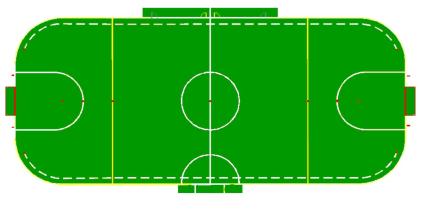It was recently reported that the USL operated Major Indoor Soccer League is no more, due to 6 of the 7 teams departing to join the rival Professional Arena Soccer League, with the remaining league changing it’s name to Major Arena Soccer League, or MASL. With that, came the information that the 2014-2015 season will be contested by 24 teams, 6 from MISL, 16 returning PASL teams, one revived team in the Tacoma Stars, and one expansion club, the Brownsville Barracudas. Four PASL teams and one MISL team are presumed to have folded.
To set the stage for the first season of unified arena soccer, I’ll be documenting the history of the uniquely North American spin on the beautiful game, and the revolving door of leagues and teams, but first, a brief summary of what arena soccer really is.
It’s basically soccer mixed with ice hockey.
Start off with a hockey rink, boards and everything. Take some synthetic turf, cover the ice, and remove the walls behind hockey’s goal line. Put a goal in each hole in the wall, flush with the boards. Goals are 14 feet by 8 feet and at least 5 feet deep, smaller than outdoors. The field is divided much like hockey, and the hockey offsides rule is used. There’s also a 3 line violation rule, where a defending player kicks the ball past both yellow lines and the white line. It gives possession to the other team, and can result in a 2 minute penalty.
Here’s a rough idea of what the field looks like, courtesy of the PASL rulebook.

Teams consist of five position players plus a goalkeeper. Rules are pretty similar, with goal kicks and corner kicks and penalty kicks all working, but teams are allowed unlimited substitutions, much like hockey, and the same benches are used. Substitutions can happen at any time, and frequently occur during play.
The boards are all in bounds, and playing the ball off them is part of basic strategy.
Arena soccer preserves the hockey penalty box, using soccer style cards to issue penalty time.
A blue card means two minutes in the box, for specific minor fouls. Fouled team plays on a two minute 5-on-4 power play.
A yellow card means five minutes in the box for more severe offenses, but no power play.
A red card means the offending player is gone, just like soccer, with blue card style 2 minute power play following. A designated player occupies the box.
Games consist of four 15 minute quarters. There’s no ties; teams play 15 minute sudden death overtime followed by a 3 man shootout if necessary.
In the MISL, goals are worth two points, with those scored from behind a special three-point arc worth three, much like basketball.
In the PASL, all goals are one point, and there’s no 3 point arc.
For lower leagues, numbers will be used to describe which generation used that particular name. MISL1 will refer to the original, while MISL will refer to the current league.